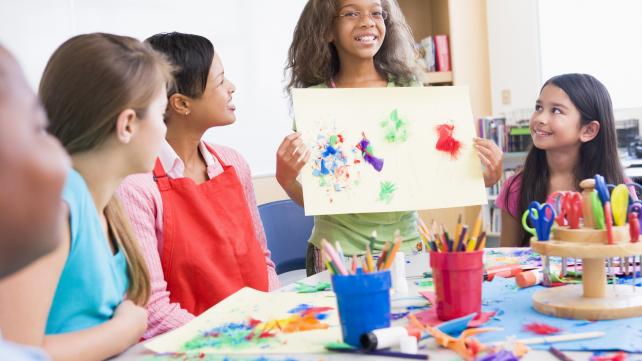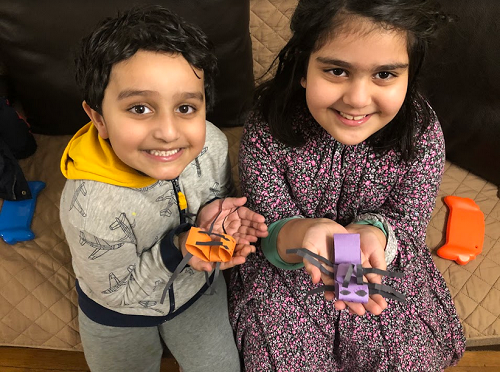
Boxes of crayons, tubs of playdough, and colored pencils are all playroom staples in many households with young children. The idea of kids drawing or coloring just makes sense. While art being fun and enjoyable is a great reason to encourage artistic activities for children, these creative practices have additional benefits that are worth noting. Cultivating and fostering creativity can have a long-lasting positive impact on the development of children.
Creating art has been an important part of my life both professionally and personally for many years. As a self-taught artist, painting and drawing were amongst my favorite activities since early childhood. As an art educator and clinical mental health counselor, creativity has also had an active role in my professional life, whether it be through the art lessons I taught my students or the art activities I engaged my clients in during our therapy sessions. Much of my work was done with children, and through my research and experience, I have seen the impact art can have on a child’s growth, development, and positive mental health.
Although the benefits are numerous, here are six skills that spring from art activities that I have observed first hand.
1. Developing Fine Motor Skills
While developing fine motor skills may be the obvious physical benefit of creative activities for children, it is still an important one. Giving young children the opportunity to explore different art mediums such as crayons for drawing, scissors for paper crafts, and clay for sculpting, allows children to develop their fine motor skills and can help with things like pencil grip, handwriting, and ability to cut straight. Using creative activities can allow kids to develop these skills in a fun and subtle way.
2. Exercising Problem Solving Skills
When children are given the ability to play around with creative materials, their brains are engaging in inquiry and experimentation. They face problems and have to come up with creative solutions to solve them. “This tape is not keeping the feather on my paper. Maybe I should use glue instead or this red color is showing on the yellow paper but not the black paper. Why is that?” Through exploring different mediums, children engage in a basic version of the scientific process, making assessments and adjusting their next steps according to what they have learned. These creative problem-solving skills can then transfer to other parts of a child’s life like reading, sports, and even in how they engage in interpersonal relationships.
3. Promoting Patience and Resilience
As someone who has taught art classes to children as young as 5 years old to adults, one thing that is consistent throughout is self-doubt and negative comments like “this is too hard” or “I can't do it.” While these examples illustrate how art can be something that leads to self-doubt, it is also an opportunity for fostering resilience. Having children learn that being patient and working on a project with multiple steps can lead to a beautiful result can help them develop a good work ethic. Additionally, children can be guided to take mistakes like spilled paint or imperfect lines and use their imagination to create something new. Understanding that failing is part of the learning process and that making mistakes is okay is an important life skill that can help little ones develop the ability to bounce back when things do not go as planned. Like problem-solving, this resilience is not only helpful in their future art practices, but can be transferred to other parts of their lives such as sports, school subjects, and even interpersonal relationships.

4. Creating Opportunities for Self-Expression
Imagination and creativity come naturally to children, regardless of whether they are innately talented drawers/painters/sculptors or not. Using art as a means to let children express themselves and communicate their emotions can be so powerful! There have been many times in my work as a counselor and therapist where children could not tell me what was going on or bothering them through their words, but they were able to do so through drawings. It is on this basis that art therapy is so successful with people of all ages. Using art as a way to help children express their thoughts, feelings, and emotions can not only make it easier for parents to understand what their child is experiencing, but can also teach children the importance of communication as well as how to identify and express their own emotions.
5. Fostering Independence, Agency, and Self-Esteem
As children grow, so does their need to be independent and make their own decisions. They do not just want to follow rules, but also have some say in the way things go. Creative activities can provide many opportunities for independence. Something as simple as letting your child choose what medium to use or how they want to draw or paint something gives them agency and allows them to feel some sense of control, that what they say matters. Art can be a safe place to allow children to make their own decisions, helping increase their sense of agency and self-esteem.
6. Strengthening Mindfulness and Self-Regulation
I use art as a way to help me relax and cope with stress, and so this point is especially important to me. As children develop self-awareness of their emotions, they also need to learn what to do to manage those emotions effectively. Creative practices such as drawing and coloring can be used as “cool down” or calming techniques.
One of my favorite lessons for 4th-grade students was on Zentangles, a drawing style in which repetitive patterns are drawn, specifically designed to have a relaxing effect. I taught this technique to students as something they could use to help manage big emotions like fear and anger. Students showed up the week after the lesson with drawings they did at home, and one student shared that he used Zentangles to help himself calm down after fighting with his little sister. Since then, I have taught similar drawings to my students and clients and found that they can be so helpful in helping little ones learn how to regulate their own emotions.
While having a cute project to hang on the fridge is always nice, the importance of engaging children in artistic practices goes beyond the final product they create. Intentionally cultivating creativity can help the physical and emotional development of children, and teach them important life skills that will benefit them throughout adolescence and adulthood, all while being colorful and fun!
Fatima Khan is a psychotherapist at Jackson Wellness Group and counselor at Tarbiyah Academy in Maryland. She is passionate about working with children and and promoting positive mental health throughout the Muslim community.



Add new comment